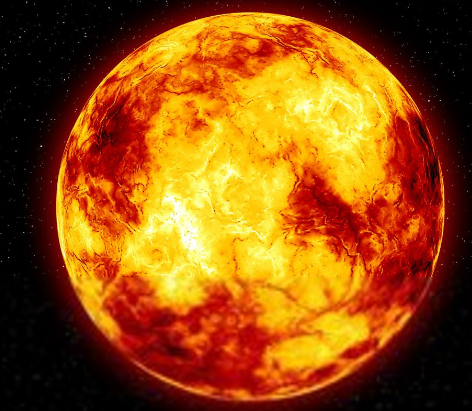(单词翻译:单击)
When you talk about space, the sun tends to come up a lot.
我们谈论太空时,常常会提到太阳。
But even though we've talked about it before, we've never given you a proper tour of our closest star.
尽管我们之前讨论过它,但从未对这颗最近的恒星进行过合适的旅行。
Today, we're going to change that.
今天,我们要改变一下了。
We'd have a bit of a problem sending a probe to the center of the sun,
我们在往太阳中心发送探测器时有点儿小麻烦,
it would vaporize long before it got there, so it wouldn't get to see very much.
它在到达之前就蒸发了,所以看不到太多东西。
But what if we sent the intrepid SciShow Space-Ship with its invincible Patreon-funded hull?
但如果我们用Patreon集资的船体发射无敌“太空科学号”,会怎么样呢?
Then we'd get to check out the sun up close,
那么我们就能近距离调查太阳了,
including the different processes going on in all its layers.
包括所有层的不同反应过程。
One of the first things we'd notice about the sun is that it's huge and it's a place of extremes.
我们注意到太阳的第一件事,是它体型巨大,环境极端。
It contains 99% of all of the matter in the solar system,
它包含太阳系99%的物质,
and just about all of it is in the form of plasma,
且以等离子体的形式存在,
a kind of superheated gas where electrons are stripped away from their atoms.
等离子体是一种电子从原子中剥离出来的超热气体。
Even the coolest places on the sun's surface are hot enough
太阳表面即使是最冷的地方也足够热,
to melt every compound humans have ever found, created, or even predicted.
能够熔化人类发现、创造和预言的所有事物。
And the sun is so big that if it were hollow, you could pack under a million Earth's inside of it.
太阳非常庞大,如果它是中空的,你可以在里面打包一百万颗地球。
But it isn't hollow, all of that plasma is organized into layers starting with the core, which makes light and heat.
但它不是中空的,所有这些等离子体形成于核心区,能够产生光和热。
And it is very hot in there, with temperatures that probably go up to 15 million Kelvin.
那里非常热,温度可能高达1500万开尔文。
Pressures are about 250 billion times what you'd find on Earth's surface,
压力大约是地表的2500亿倍,
making the plasma eleven times denser than lead.
使得等离子体的密度是铅的11倍。
At those temperatures and pressures, smaller atoms start combining into larger ones,
在此等温度和压力下,小分子开始合并成大分子,
in a process known as nuclear fusion, which releases a lot of energy.
这个过程被称为核聚变,释放了很多能量。
It's how the sun, like every other star, shines.
这就是太阳和其他恒星发光的方式。
The sun produces about 420 million billion billion Watts of power every second.
太阳每秒钟产生约4.2*10^26瓦的能量,
That's 750,000 times all the energy all of humanity uses in a whole year... produced every second!
这是人类全年使用能量总和的75万倍,每秒产生这么多!
The energy's released in the form of light,
能量以光的形式释放,
which flies away from the reaction in a random direction.
从任意方向飞离反应,
But it doesn't just zoom straight out of the sun from there.
但它不能从这里直接飞出太阳。
According to most estimates, it actually takes about 200,000 years for the light from the core to reach the surface.
根据大多数估计,实际上,光从太阳核心到达表面需要20万年。
The sun is only about four light-seconds across,
太阳大约只有4光秒宽,
so a photon of light should only take about four seconds to cross the entire thing, if it were an empty shell.
所以它是空壳的话,光子只需要4秒就能穿过去。
But the center of the sun is so dense that light can only travel for about a hundredth of a nanosecond before running into an atom.
但太阳中心的密度非常大,以至于光在进入原子前,只能以大约百分之一纳秒的速度前行。
That's only about a centimeter, in a star 140 billion centimeters across.
相当于在1400亿厘米的太阳中只走了1厘米。
When the light hits an atom, that atom absorbs energy and releases some of it as more light,
光线照射到原子时,原子吸收能量并释放更多的光,
which goes off in another random direction for another hundredth of a nanosecond before it's absorbed,
释放的光在被吸收之前,又以百分之一纳秒的速度向其他任意方向进行,
and then the process starts all over again.
然后这个过程又开始了。
It's not a very efficient way to get somewhere, but eventually the light ends up at the edge of the core.
光去某个地方并不是非常有效的方法,但最终都会到达核心边缘。

Meanwhile, the energy absorbed by each atom makes it a little warmer.
与此同时,每颗原子吸收的能量使它更热了。
Once it's out of the core, light enters the radiative zone,
光一旦脱离核心区就进入了辐射层,
which starts at around a third of the sun's radius and keeps going until about two thirds of the radius.
辐射层从太阳半径的三分之一开始一直持续到半径的三分之二。
There, the light just keeps running into atoms and transferring energy to them.
在那里,光不断进入原子并向它们传递能量。
The light and heat radiate outwards from the core towards the edges of the sun, hence the name.
光和热从核心向外辐射到太阳边缘,它因此得名。
But only about 1% of the sun's fusion happens in the radiative zone because,
但只有约1%的太阳聚变发生在辐射区,因为,
by this point, the temperatures, pressures and densities are all way too low.
这一层的温度、压力和密度都太低。
By the time it gets to the end of the radiative zone,
当等离子体到达辐射区的边缘时,
the plasma is about a tenth of the temperature and a hundredth of the density it was at the center of the core.
它的温度只有离开核心区时的十分之一、密度为百分之一。
Most of the rest of the sun is taken up by the convective zone.
太阳的其余大部分是对流层。
At this point, instead of light mostly transferring energy directly to atoms and making heat that way,
在此区域,光没有将大部分能量直接转移给原子,制造热量,
the light just kind of passes by, and atoms transfer heat to each other in a process called convection.
它只是正好经过,原子相互转移热量的过程叫做对流。
It's the same way heat circulates in the convection oven you might have in your kitchen:
它和你厨房里对流烤箱的热循环是一样的:
hot stuff rises and cooler stuff falls.
热物质会上升,冷物质下降。
Temperatures continue to drop across the convective zone until we reach the photosphere,
温度在经过对流层时持续下降,直到到达光球层,
the main layer you'll see if you look at the sun through a special solar telescope.
它是你通过特殊太阳能望远镜看到的主体层。
The photosphere is about 5,700 Kelvin, which is still way too hot for a stroll,
光球层的温度大约是5700开尔文,散步仍然太热了,
but practically freezing compared to the 15 million Kelvin we saw in the core.
但与核心区的1500万开尔文相比,简直是冰冷。
And just outside of that layer is one of the sun's biggest mysteries,
光球层外面的一层是太阳最大的谜题之一,
in the form of a few wispy layers known as the chromosphere and the corona,
以被称为色球层和日冕的束状形式存在,
which can be millions or even tens of millions of Kelvin.
它的温度可能有百万甚至几千万开尔文。
That is way hotter than the photosphere, and researchers don't really know what's heating it.
这比光球层热多了,研究人员不知道什么为它加热。
It seems to contradict both thermodynamics and basic common sense:
它似乎与热力学和基本常识相矛盾:
something cold shouldn't be able to heat something warm.
冷物质不能加热热物质。
There are a few possible explanations,
有几种可能解释,
magnetic fields in the sun might be dragging matter around and superheating it in the process, but scientists still aren't sure.
太阳磁场可能会拖曳周围的物质,并在过程中加热,但科学家们仍不确定。
Thanks for joining us on this trip in the SciShow Space-Ship,
感谢您加入到我们的太空科学旅行,
and thanks especially to our patrons on patreon who help make this show and that ship possible.
同时感谢patreon对我们的大力支持。
If you want to help us keep exploring the universe,
如果想帮我们继续探索宇宙,
just go to patreon.com/scishow to learn more.
就登陆patreon.com/scishow了解更多信息吧。


